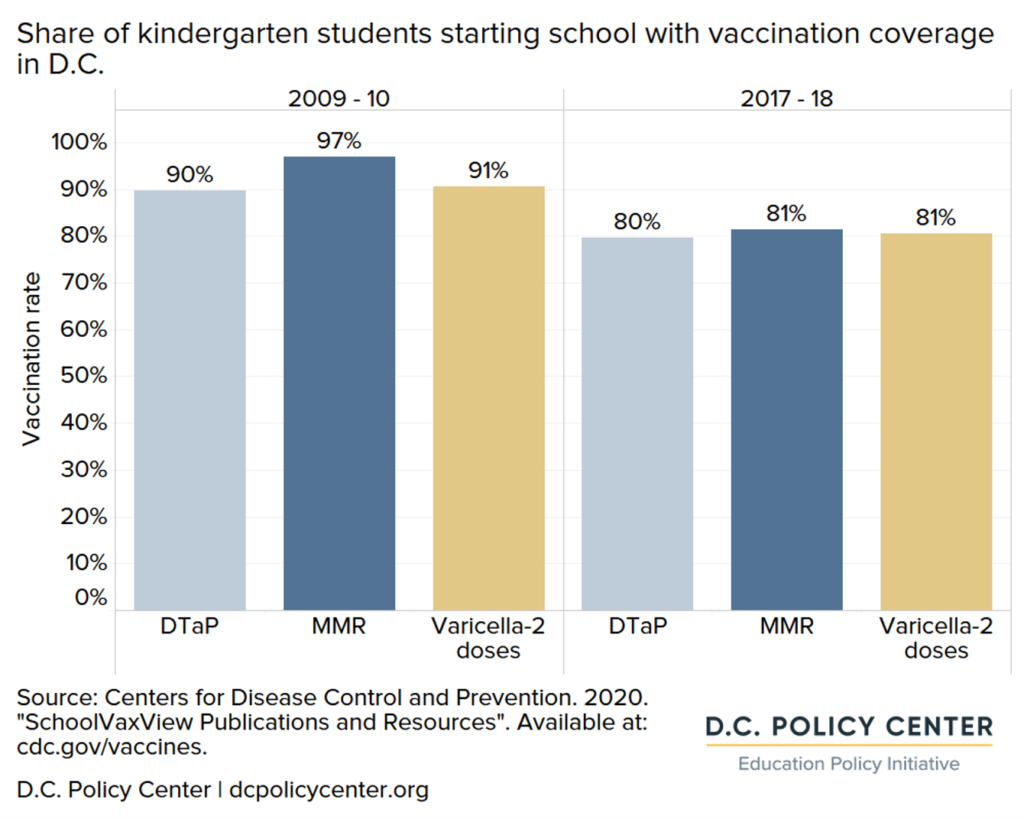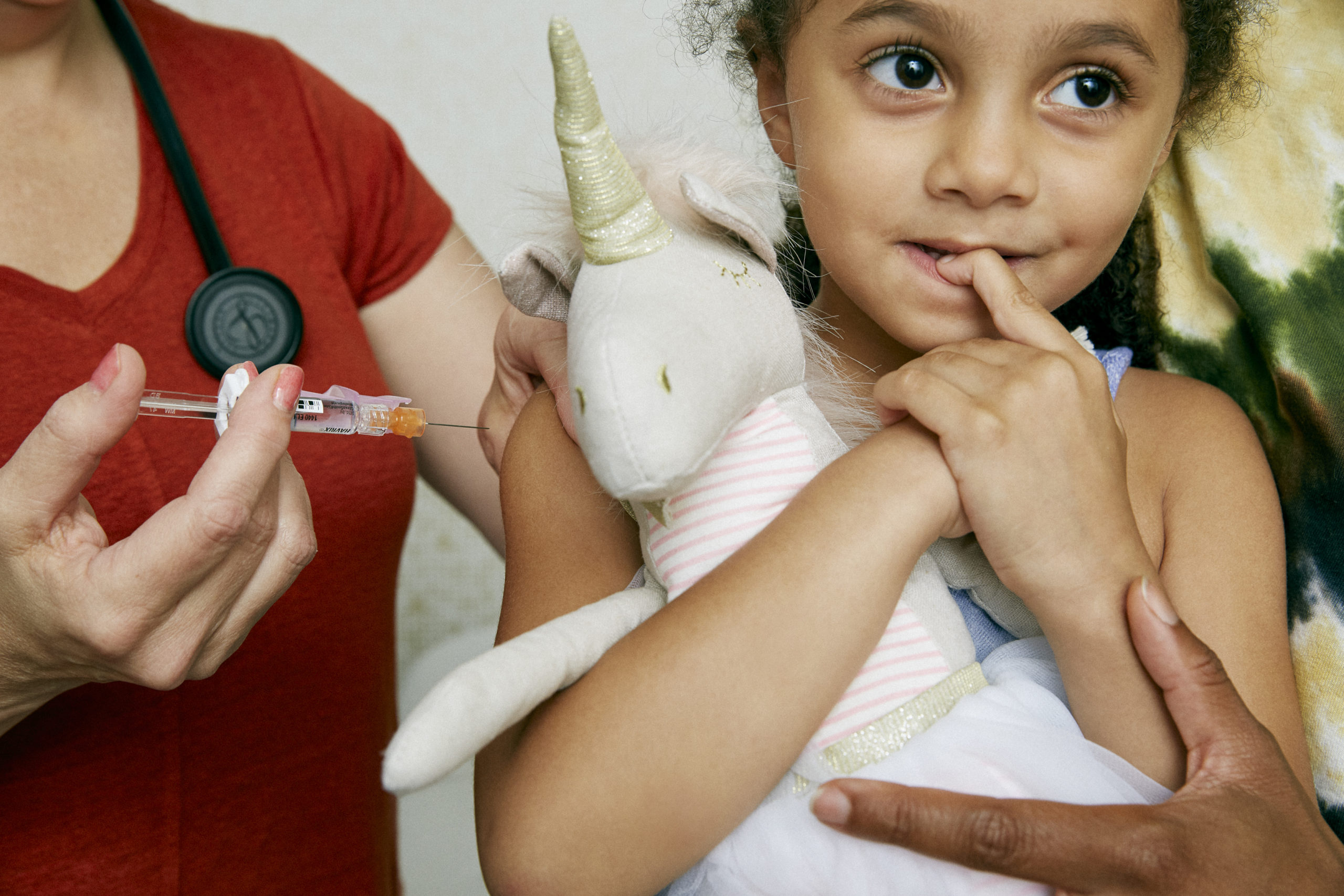In D.C., students are required to receive certain vaccines to attend school,[1] a practice that increases community protections against potentially life-threatening diseases. However, data show that routine vaccination rates among kindergarteners in D.C. are declining, and had been even before the COVID-19 pandemic began. Between the 2009-10 and 2017-18 school years, the share of kindergarteners starting school with DTaP (Diphtheria, Tetanus, and Acellular Pertussis) and Varicella vaccines dropped by 10 percent each. During the same time frame, the vaccination rate for MMR (Measles, Mumps, and Rubella) dropped from 97 percent of kindergarteners to 81 percent, lower than every state in the country.[2]


Measles, a disease included in the MMR vaccine, is the most contagious of vaccine-preventable diseases, and is ten times more contagious than COVID-19.[3] It can cause pneumonia, which is the most common cause of death from measles in young children, and encephalitis, a swelling of the brain that can leave children deaf or with intellectual disability.[4] In 2019, D.C.’s vaccination rate for measles was 93 percent for all students attending traditional public schools and public charter schools – two percentage points below the 95 percent herd immunity threshold. This gap in immunization increases the risk of an outbreak.
During the COVID-19 crisis, many families delayed or stopped seeking preventive care, including well-child visits, leading to an even sharper decline in routine childhood vaccinations. Between March and May 2020 – the first few months after the public health emergency was declared – the District saw a 70 percent decline in vaccinations among children three years old and younger, and a 42 percent decline in vaccinations in all children, relative to 2019.[5] D.C.’s initial drop was more precipitous than national declines. Through September 2020, 26 percent fewer doses of DTaP vaccines were administered nationwide than in 2019, 26 percent fewer doses of MMR vaccines were administered, and 16 percent fewer doses of polio vaccines were administered.[6]
All 50 states and D.C. have laws and regulations requiring specific vaccines for students,[7] and in a typical year, schools would enforce these mandates by ensuring students were up to date on their vaccinations before returning to school in August. Some schools – including several in D.C. – even administer vaccines to students who need them.[8] But in 2020, most schools in D.C. began the school year remotely, limiting their ability to play a meaningful role in ensuring adequate vaccination rates.[9] Instead, to address the decline in routine vaccinations, the District launched its Stay on Track! campaign, urging families to keep up with vaccinations. The city sent letters to families, notifying them of overdue vaccines, and sharing information on where to get them. It also opened up its seven school-based health centers that traditionally serve their own students to all students in the District who need vaccinations.[10]
To learn more about D.C.’s approach to routine childhood vaccinations, the D.C. Policy Center reached out to an assistant superintendent at OSSE, a family medicine doctor, and a parent to ask the following questions: How are families and schools approaching routine vaccinations? What implications does this have for an eventual return to in-person learning?
Heidi Schumacher, MD, Assistant Superintendent of Health and Wellness, D.C. Office of the State Superintendent of Education
To address this urgent need, the District government has taken numerous steps to partner with health care providers, schools, and child care providers to expand access to vaccinations and to ensure that all students participating in in-person school or child care are fully immunized.
Heidi Schumacher, MD
At the D.C. Office of the State Superintendent of Education (OSSE), we believe that healthy bodies and minds are the foundation of academic success. Throughout this coronavirus (COVID-19) pandemic response, school and child care educators and staff have embraced an unprecedented focus on the health and wellbeing of school and child care communities, including an intentional focus on mental health and trauma, extensive new health and safety policies and procedures, and targeted upgrades to facilities.
Beginning the week of January 25, 2021 the District anticipates it will enter Phase 1B -Tier 2 of the COVID-19 vaccine delivery, during which educators and staff from District pre-K-12 schools and child care providers will become eligible to receive the vaccine. This is a tremendously exciting step forward in our collective response to this pandemic and its impact on our daily lives. Future phases of the vaccine’s roll-out will capture children, families, and community members, ultimately resulting in a goal of herd immunity across the entire population.
Amid our focus on COVID-19 protocols and vaccinations, we must not neglect the urgent need to maintain high rates of vaccination for routine, vaccine-preventable illnesses such as measles and whooping cough. Many health clinics closed temporarily in the early days of the pandemic, and even though health care providers are now largely open and offer robust health and safety protocols, many families have avoided health care institutions due to safety concerns.
This resulted in a significant decrease in administrations of vaccines across the country, with up to 70 percent fewer immunizations being ordered for and administered to District children and adolescents in spring 2020 compared to the same period in prior years. This raises concern for the possibility of an epidemic of a deadly vaccine-preventable illness such as measles, on top of COVID-19. As a pediatrician, the prospect of this layered public health emergency is deeply concerning.
To address this urgent need, the District government has taken numerous steps to partner with health care providers, schools, and child care providers to expand access to vaccinations and to ensure that all students participating in in-person school or child care are fully immunized. DC Health launched a broad public messaging campaign, and expanded public sites at which students and families could access vaccines. OSSE created a webpage for schools that includes detailed step-by-step guidance, FAQs, and tips for enforcement of the immunization requirements for students. OSSE and DC Health continue to offer regular technical assistance to schools and child care providers, who are required to review immunization records and engage with students and families to ensure that all students participating in in-person activities are up-to-date on their vaccines.
The COVID-19 pandemic has introduced extraordinary challenges to the provision of in-person instruction and activities in schools and child care. The public health emergency has also shown us, though, that with creativity and focus, we can ensure the safest possible environments for our students, families, and staff, including high rates of immunization compliance.
Will Dixon, MD, Board Certified Family Medicine physician at Upper Cardozo Health Center
I’m optimistic, however, that so long as these vaccinations are delayed rather than deferred, we will not see a significant resurgence of most of these pathogens.
Will Dixon, MD
Among the different scientific innovations that have improved our lives, vaccines may be the most under-appreciated. Without their protection, many of the people you know likely would have suffered premature death and disability. Vaccines have helped so much that they’ve become victims of their own success: deaths by tetanus or paralysis by polio have become phenomena of history books rather than daily life, leading many to forget their importance.
As well-child checkups and therefore vaccinations have dropped during the COVID-19 pandemic, there’s a very real fear that decades of work [for public health] will be undone. I’m optimistic, however, that so long as these vaccinations are delayed rather than deferred, we will not see a significant resurgence of most of these pathogens. We enjoy the protection of herd immunity from the already-vaccinated: with so many protected, outbreaks cannot reach the exponential spread that we’ve seen with COVID-19.
While many of the visits we do at Unity Health Care have become virtual, we continue to prioritize getting children into the clinic for their scheduled vaccinations. We have worked to make the clinics as safe as possible for families, including requiring masks inside, reducing the number of people accompanying patients into the clinic, and doing as many visits via telemedicine as we can to reduce exposure. The decision to enter into a public space during a pandemic is a difficult one and must be individualized, but if parents are planning to have their children return to in-person learning, I really encourage them to make sure they’re up to date with their required vaccinations.
Maxine Robinson, Ward 7 PAVE parent leader
I’m also nervous about [my sons] interacting with other students who might not be fully vaccinated, as some vaccine-preventable diseases can be life threatening.
Maxine Robinson
I have four sons, and during the pandemic, we kept up with each of their vaccination schedules. We were able to do so because we see a pediatrician who makes us feel safe and comfortable. I’m a health professional, and our pediatrician was able to answer all my questions about vaccines, dosages, and injuries. He also has a private practice that implements excellent safety protocols. When I went to the doctor, my family and I were the only ones in the office. The next family didn’t come inside until after we left. He is also a man of color, which increases my trust in him. Depending on the insurance people have and what kind of pediatric care they’re receiving, I can understand why some families might choose to delay wellness visits and routine vaccinations.
I’m concerned about my sons returning to in-person learning. They haven’t been sick in a whole year. As a professional, I know that exposure to germs will make them stronger, but as a mother, I know how hard it is to take care of a sick child. I’m also nervous about them interacting with other students who might not be fully vaccinated, as some vaccine-preventable diseases can be life threatening. Ideally, when we return to in-person learning, schools would be able to identify students who are behind on their routine vaccinations and administer those vaccines on site. If we’re unable to find innovative, community-oriented solutions, I’d be a bit hesitant to send my kids back to school. I might consider sending them back in waves, with the oldest going back first. I’d also have conversations with them about hand hygiene and being in close proximity with their peers.
Read more about the impact of COVID-19 in the District of Columbia.
